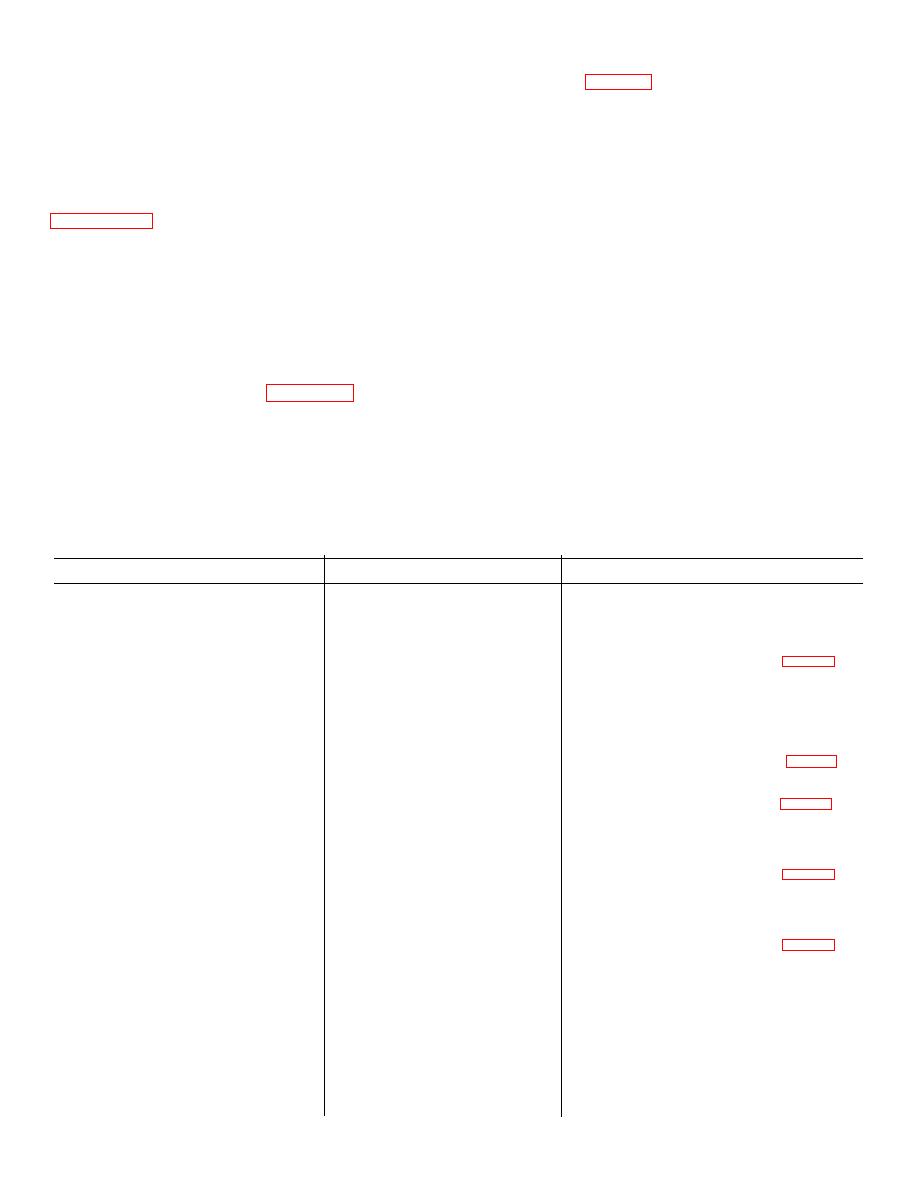 |
|||
|
|
|||
|
|
|||
| ||||||||||
|
|
 TM 11-6625-2478-12
c. Use a soft-bristle brush to remove dirt from
malfunction in table 4-6 and perform indicated corrective
action for probable cause.
connectors. Use a clean, dry, lint-free cloth to remove
4-8. Removal and Replacement of Indicator
moisture.
4-6. Repainting and Refinishing
Lamps and Lens Caps
a. Removal To remove indicator lamps lA3DS1
If necessary, refinish or touch up painted surfaces or
Simulator, Monitor Input SM-627/AYM-9 and Case, Test
through lA3DS21, proceed as follows:
Set CY-7117/AYM-9 as follows:
(1) Unscrew lens cap counterclockwise until free.
a. Clean surface to be painted in accordance with
(2) Remove indicator lamp from lens cap.
b. Replacement. To replace indicator lamps 1A3DS1
b. Remove rust and corrosion with fine sandpaper
through 1A3DS21, proceed as follows:
FSN 5350-235-0124.
(1) Insert new lamp into the lens cap base up.
c. Brush two thin coats of paint (only on those parts
(2) Screw lens cap into lampholder clockwise until
meant to be painted) on the bare metal to protect it from
secured.
c. Removal. To remove indicator lamps 1A3DS22
further rust or corrosion.
Refer to the applicable
cleaning and refinishing practices specified in TB 746-
through lA3DS26 and lA3DS28, proceed as follows:
10. Refer to SB 11-573 for paint to be used.
(1) Unscrew lens cap counterclockwise until free.
4-7. Troubleshooting
(2) Grasp lamp base at its rim and pull from the lens
To isolate the causes of troubles which may occur, refer
cap.
to the troubleshooting chart, table 4-6. The table
provides corrective maintenance procedures for
malfunctions that may be observed during preventive
maintenance checks. It also covers malfunctions that
may be observed during normal operation. References
given in the corrective action column are to paragraphs
giving instructions for corrective maintenance at the
operator and organizational level.
Find applicable
Table 4-6. TroubleShooting Chart
Item
No.
Malfunction
Probable Cause
Corrective Action
a. Defective Cable Assembly, Power,
a. Refer to next higher category of
1
None of the following indicator lamps,
light when ON-OFF switch is set to ON:
Electrical CX-127/AYM-9
maintenance.
b. Defective shop power source.
b. Refer to next higher category of
-522DC, + 500 DC,--VDC,
115VDC, and 115VAC.
maintenance.
a. Defective indicator lamp or lamps
2
One or more of the following indicator
lamps do not light when ON-OFF
b. Defective Simulator, Monitor Input
b. Refer to next higher category of maintenance.
switch is set to ON -522V'DC,
+ 50VDC, -80VDC, 115VDC, and
SM-627/AYM-9
and 115VAC
a. Defective indicator lamp or lamps.
a. Press BCD-PRESS TO TEST
3.
One or more of the following indicator
lamps do not light when ON-OFF
pushbutton switch If indicator lamp
switch is set to ON. 6.3VAC, GO, and
or lamps still do not light, replace. (para 4-8.)
b. Defective Simulator, Monitor
b. Refer to next higher category of
+ 5V
Input SM-627/AYM-9.
maintenance.
a. Defective indicator lamp or lamps.
4.
One of more of the BCD + 3 indicator
lamps do not light when BCD * 3-
b. Defective Simulator, Monitor
b. Refer to next higher category of
PRESS TO TEST pushbutton switch
is pressed
Input SM-627/AYM-9
category of maintenance.
a. Defective indicator lamp or lamps
5.
One or more of the DECIMAL indicator
lamps do not light hen DECIMAL-
b. Defective Simulator, Monitor
b. Refer to next higher category or
PRESS TO TEST pushbutton switch
is pressed
Input SM-627/AYM-9
maintenance
a. Defective indicator lamp or lamps.
6.
One or more of the following indicator
b. Defective Simulator Monitor Input
b. Refer to next higher category of
lamps do not light when BCD-PRESS
TO TEST pushbutton switch is pressed
SM-67/AYM-9
maintenance.
BCD, BATTERY INDICATOR,
SINGLE P'ULSE INDICATOR,
6 3SAC, GO, + 5V, and FAILURE
7.
FAILURE indicator lamp lights at any
Defective Simulator, Monitor Input
Refer to next higher category of
time other than during BCD--PRESS
SM-627/AYM.
maintenance.
TO TEST indicator lamp test
4-4
|
|
Privacy Statement - Press Release - Copyright Information. - Contact Us |